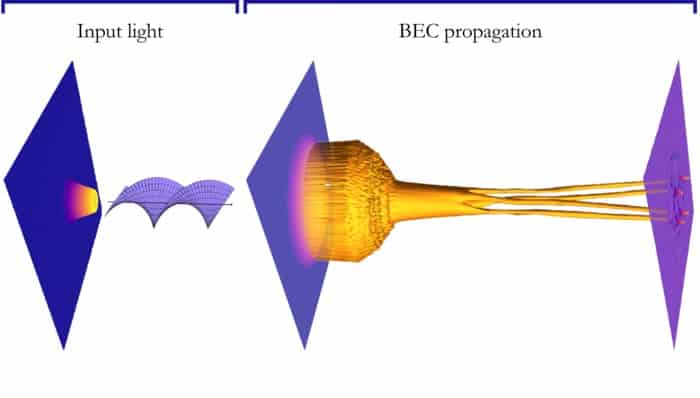
Researchers in the UK have done calculations that show how “twisted light” can be used to manipulate the ultracold atoms in an exotic state of matter called a Bose–Einstein condensate (BEC). Using theoretical models, Grant Henderson and colleagues at the UK’s University of Strathclyde discovered that light–matter solitons could be generated through the interaction between corkscrew-shaped wavefronts of light and BECs.
BECs are an exotic state of matter, in which a gas of identical atoms is cooled close to absolute zero. This drives a large fraction of the atoms into the lowest quantum state, and when this occurs the physics of the gas is defined by a macroscopic wave function.
One particularly interesting feature of BECs are solitons, which are wave packets that maintain their shapes as they travel. Solitons are also found across a wide array of fields, including hydrodynamics, ferroelectric materials and superconductors.
A spatial optical soliton occurs when the diffraction of light in a medium is carefully balanced by self-focusing. Self-focusing is a non-linear effect that involves the light itself changing the optical properties of the medium.
Twisting dipoles
In their study, Henderson’s team explored a more complex scenario. Instead of a conventional laser beam with a Gaussian intensity distribution, they considered “twisted” light. This is light with a wavefront that twists around its axis of travel like a corkscrew. These beams carry orbital angular momentum, which means that they can rotate atomic-scale electric dipoles that they encounter in a medium.
The team calculated what would happen when a beam of twisted light interacts with the atoms of a BEC that is moving in the same direction as the light. They predict that the self-focusing effect would cause the the twisted light to fragment into solitons. Since the BEC’s atoms are attracted to high-intensity light, the atoms would be “captured” by the optical solitons. The result is the creation of coupled light–atom wave packets.

Light forks one way in a Bose–Einstein condensate
The atoms in these packets twist as they propagate, and the team found that the number of packets created is equal to twice the orbital angular momentum of the twisted light. The above figure, for example shows the creation of the four solitons that would occur when light with an orbital angular momentum of two interacts with a BEC.
The discovery presents a simple new technique for sculpting exotic matter into complex shapes, and carefully controlling the transport of BEC atoms. Henderson and colleagues now propose that the effect could be harnessed in novel quantum technologies: including ultra-sensitive detectors, and circuits that use neutral atoms to convey currents.
The research is described in Physical Review Letters.
